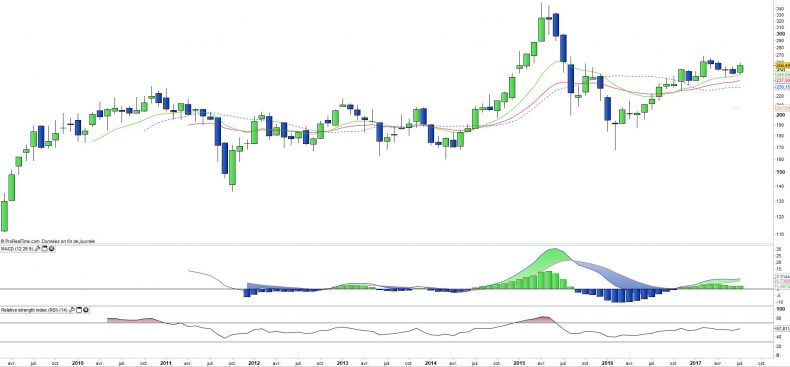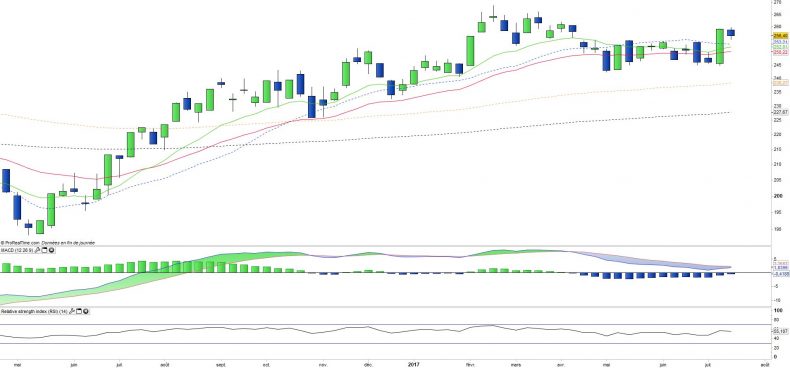Amundi ETF China (CC1) - 21/07/2017
Short term strategy : Positive (60%) / Trend +
Long term strategy : Positive (95%) / Trend +
Characteristics of the ETF
ETF CC1 (Amundi) replicates the MSCI China H index, net dividends reinvested.
The shares included in the MSCI China H Index are from the largest equity universe in the Chinese market. The MSCI China H Index is composed of 68 constituents and is therefore relatively diversified. The financial sector (banks and insurance companies), however, accounts for about half of the capitalization while China Construction Bank accounts for 15% of the index.
Chinese equities H are the shares of mainland China (Hong Kong) listed companies or other foreign market places. These shares are subject to Chinese regulation but denominated in Hong Kong dollar (HKD). H shares are, unlike A shares, available to non-resident investors in China. The maximum tracking error between the Fund's NAV and the MSCI China H Index is 2%. This tracker has a currency risk related to the exposure of the MSCI China H Index, resulting from the change in the reference currency, the Hong Kong dollar (HKD).
Dividends are capitalized and expenses of this ETF are 0.55%, which is fairly typical for an emerging index. Assets Under Management : 85.7 €M.
This ETF makes it possible to hold the main Chinese companies in the portfolio. China is the world's second largest economic power behind the US with a GDP of around $ 12,000 billion in 2016, the world's largest exporter and have the world's largest foreign exchange reserves. The global recession of 2009 interrupted the continuous growth momentum in which China was engaged, and showed the limits of a growth mainly focusing on exports. Given the global economic downturn and falling trade, China's growth has decelerated to below 7% in 2015, its lowest level in 25 years, and this trend is set to continue. In 2016, growth reached 6.6% GDP. The debt of state-owned enterprises accounts for 145% of GDP, while private sector debt would have accounted for nearly 210% of GDP in the 2016 peak. Consumption is slowing and the yuan's decline against the dollar currently leads to capital flight, as a result the central bank's foreign exchange reserves are dwindling somewhat. Moreover, the quality of banking assets is deteriorating and this trend is probably underestimated due to the importance of the shadow banking.
There are still many challenges related to the problem of an aging population, the shrinking of the labor force, the lack of openness of the political system, the competitiveness of an economy dependent on high investment spending and credit. Manufacturing and construction sectors contribute nearly half of China's GDP, but the country is increasingly focusing on services and domestic consumption. China has just set its new growth target for 2017, at around 6.5%, which means a gradual soft landing linked to the new growth model, based more on quality, which correspond to an upgrading of the industry and Services but also focused on reducing the current major imbalances (excessive debt, overcapacity in industry and real estate). China definitely does not seem to be in the race for growth anymore but in search of a more balanced and sustainable model whose base is the rise of its industry by the technology and the expansion of services and domestic consumption.
The Chinese economy grew at a faster pace than expected in the second quarter, amid optimistic figures for industrial production, consumption, and investment. Gross domestic product (GDP) grew by 6.9% year-on-year in the second quarter. However, it is possible that growth will slow in the second half of the year, against a background of credit restriction by authorities concerned to avoid overheating of house prices and indebtedness.
Monthly data
The analysis of the monthly charts shows a rising trend, which is developing since the end of the year 2016 but which does not really manage to accelerate by forming new higher ones. After a good start to the year, the index has corrected with a return on the EMA13 but seems willing to start a new wave of rise in July, up 4% for now.
Exceeding the high of February at 269 pts is important for the trend to truly enter momentum.
Weekly data
On the weekly charts, we see that a downward crossover of the 13x26 moving averages was narrowly avoided, thanks to the sharp increase last week (+ 5.2%). This surge will have to be confirmed in the coming weeks, so that the trend is really revived.
The MACD is expected to turn bullish in the near future, and the index should exceed the highest of the year. In this case the trend should regain momentum.
ETF Objective
CC1 is an ETF which seeks to replicate the performance of the MSCI China H Index (68 companies)
Characteristics
| Inception date | 03/03/2009 |
| Expenses | 0,55% |
| Issuer | Amundi |
| Benchmark |
MSCI China H
|
| Code/Ticker | CC1 |
| ISIN | FR0010713784 |
| UCITS | Oui |
| UE-SD Status | Out of Scope |
| Currency | Euro |
| Exchange | Euronext Paris |
| Assets Under Management | 85,7 M€ |
| PEA (France) | Yes |
| SRD (France) | Yes |
| Currency Risk | Yes |
| Number of Holdins | 68 |
| Risk | 4/5 |
Country Breakdown
| China | 100% |
Sector Breakdown
| Financials | 68% |
| Energy | 10% |
| Industrials | 7% |
| Consumer Discretionary | 4% |
| Materials | 3% |
| Utilities | 2% |
| Health Care | 2% |
| Others | 4% |
Top Ten Holdings
| China Construct Bank | 14% |
| ICBC | 11% |
| Bank of China | 9% |
| Ping an Assurance | 8% |
| China Life Insurance | 5% |
| China Petroleum Chem | 4% |
| Petrochina Co | 3% |
| Agricult BK China | 3% |
| China Merchants Bk | 3% |
| China Pacific Insur | 2% |


